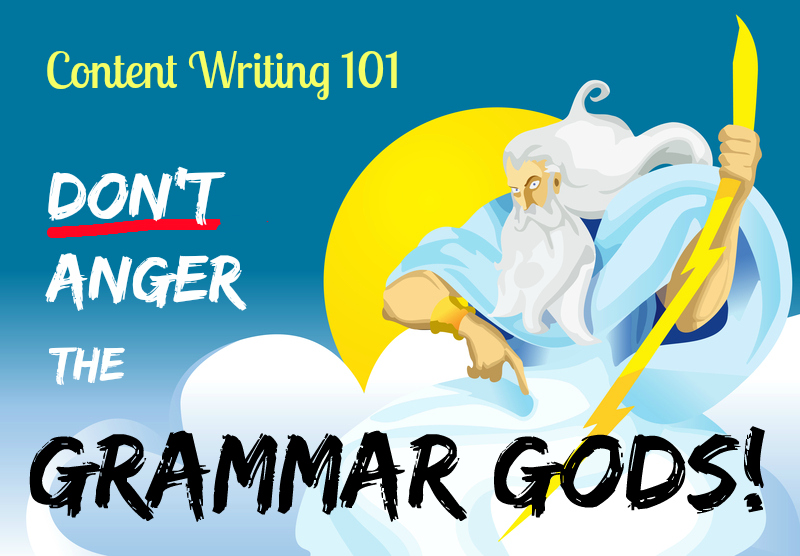By Becky Tumidolsky
Every time I see content that runs afoul of the Grammar Gods, I feel a twinge of pain—not for me, but for the brand that just took a hit.
Grammar errors can be extremely costly. In fact, they have the power to nullify the entire investment of time and resources marketers commit to producing content in the first place.
Smart, sophisticated audiences (especially the B2B variety) are much less inclined to share content, let alone give brands serious consideration, when they see writing that couldn’t pass a sixth-grade English exam.
I don’t often write about the mechanics of good writing (I usually blog about topics related to audience engagement). But this week, out of a sincere desire to serve, I put together a list of 10 of the most egregious grammar errors so you’ll know what to watch for on your next editing pass.
Before You Publish, Proof and Proof Again
Proofreading, even multiple rounds of it, is never a waste of time. Consulting a dictionary or grammar guide is never a waste of time. In the content creation game, points aren’t awarded for speed. Excellence is all that matters.
I have many tools at my disposal when I’m crafting copy: Merriam-Webster Online, The Copyeditor’s Handbook by Amy Einsohn, and the AP Stylebook, among others. Like all conscientious writers, I refer to them regularly.
If you do nothing else today, give these 10 items your full attention—for the sake of your readers and your brand.
1. Know Your Possessive Pronouns.
“It’s” is a contraction meaning “it is.” Similarly, “you’re” = “you are” and “who’s” = “who is.”
Think of it this way: “You’re content should be error-free” literally means “You are content should be error-free.”
Get it? Good. Now, for the love of the Grammar Gods, go forward and spread the good news!
2. Know Your Homophones.
Word pairs such as “adverse” and “averse,” “eminent” and “imminent,” and “dessert” and “desert” (and let’s not forget the notorious trio “weary,” “wary,” and “leery”) can easily trip up the most diligent content creators. From your readers’ point of view, confusing these words in your writing is an unforgivable sin.
When in doubt, look it up! (Better yet, look it up anyway!) Get a good mobile dictionary app and make it a habit.
3. Know How to Punctuate When Quotation Marks Are Present.
Here are some sample sentences to illustrate the rules.
Using a period:
Explain to me the term “native advertising.”
(Note: This is the American standard. The British standard is to put the period outside the quotation marks. Punctuate accordingly based on who you are.)
Using a question mark:
Do you understand the term “native advertising”?
My son kept asking, “Are we there yet?”
Using a colon or semicolon:
These “Grammar Gods”: Do they actually exist?
I detest the nonword “irregardless”; I want to scream into a pillow whenever someone says it.
Using parentheses:
He asked me to do him a favor (he referred to it as a “solid”).
4. Know How to Avoid Dangling Modifiers.
Want to give audiences a good laugh at your expense? Of course you don’t. Avoid dangling and misplaced modifiers at all costs.
Example: Daydreaming about the book I hope to write, the barking dog shattered my concentration.
(The dog was daydreaming about a book? Now that’s one smart dog.)
When you put too much daylight between your modifier and the noun to which it refers (or ditch the noun altogether), you’re asking for trouble. Our sample sentence has a simple fix: “While I was daydreaming….”
5. Know That a Company Is Never a “They.”
When referring to a corporate entity, never use the pronouns “they” or “their.”
Example: When XYZ Company led the field, they were known for their unique corporate culture.
You’ve probably seen this construction a million times, but it’s incorrect. If using “they” and “their” seems more natural in a given context, make sure these pronouns refer specifically to shareholders, executives, employees, or some other representative group.
6. Know How to Make Your Series Parallel.
“Cindy went to the store to buy candy, cookies, and get change for a dollar.” (I didn’t realize “get change” is another item on the shelf.)
All items in a series must belong to the same part of speech.
In more complex sentences, this kind of mistake is easy to make and tougher to avoid. But avoid it you must.
Examples:
Al loves to garden, brew beer, and watch football.
Your prospects enjoy reading content that piques their interest, resonates with them, and offers a unique benefit.
This project will be on time, under budget, and beyond your wildest expectations.
7. Know the Proper Uses of “Me,” “Myself,” and “I.”
Some people think it sounds more formal or proper to use “I” as an object or “myself” as the object of someone else’s action. Those people are mistaken.
Examples:
The CEO called a meeting with Robin and I.
The CEO lavished praise on Wendy and myself.
In both of these sentences, “me” is the only appropriate pronoun to use.
8. Know When NOT to Use Adverbs.
The “I” vs. “me” people also mistakenly believe that a speaker sounds more educated if he says, “This mystery meat smells badly”—as though the “ly” reflects a keener intellect.
When used to express a state of being, verbs such as feel, smell, sound, and taste take an adjective.
It’s fine to tell people you “feel good” and that you’re “doing well,” but never tell someone you’re “doing good” unless you’re performing charitable work.
9. Know When to Use Commas.
As everyone knows, commas can transform the meaning of a sentence.
“Let’s eat Grandma.”
“Let’s eat, Grandma.”
They can also give readers a welcome pause, prevent confusion, and add emphasis to key elements.
In sentences like these, the comma is nonnegotiable:
- Gil’s wife, Barbara, accompanied him to the dinner. (The commas should only be absent if Gil has more than one wife.)
- If you truly empathize with them, people who read your content will know it and respond positively. (You don’t want readers tripping over “them people.”)
- However, you choose your own fate. (Without a comma, this would appear to be a sentence fragment.)
In many sentences, however, comma placement is purely a judgment call. In the case of the serial comma (before “and” or “or” at the end of a series), it’s usually a matter of house style. The trick to using commas correctly is to err on the side of using as few as possible and to always use common sense.
If you’re really confounded, consult a grammar reference, style guide, or writer who lives and breathes this stuff.
10. Know “That” vs. “Which.”
“I love art museums which showcase a wide variety of artists.” (Ack!)
“That” and “which” are often thought to be interchangeable. But in most cases, they serve very different purposes.
Examples:
I love art museums that showcase a wide variety of artists. (Here, you’re referring to a particular type of art museum.)
I love art museums, which showcase a wide variety of artists. (Here, you’re suggesting all art museums showcase a wide variety of artists.)
Notice that the comma plays a big role here as well.
Sadly, We’ve Reached the End of Today’s Lesson
Just kidding. I know this has been a long slog. You’re free to return to your regularly scheduled content curation time.
One more thing before you go: Are there any particular grammar mistakes that drive you bonkers? Are there rules listed here or elsewhere you’d like clarified? Leave a comment below, and I’ll give it my best shot.

Since 2001, Becky Tumidolsky has written awareness-building content for B2B brands and their discerning audiences. Her work has appeared in leading publications such as Forbes, U.S.News & World Report, Bloomberg Markets, Newsweek, and Inc. as well as corporate blogs, websites, white papers, and other content assets.
Becky loves writing fluid, error-free prose. She’s even more passionate about building the foundation for her work—uncovering core brand distinctions, framing them thematically, and developing fresh, compelling narratives that advance corporate strategies.
Follow and connect: Twitter| Google+| LinkedIn| Facebook






Leave a Reply to Peg Cancel reply